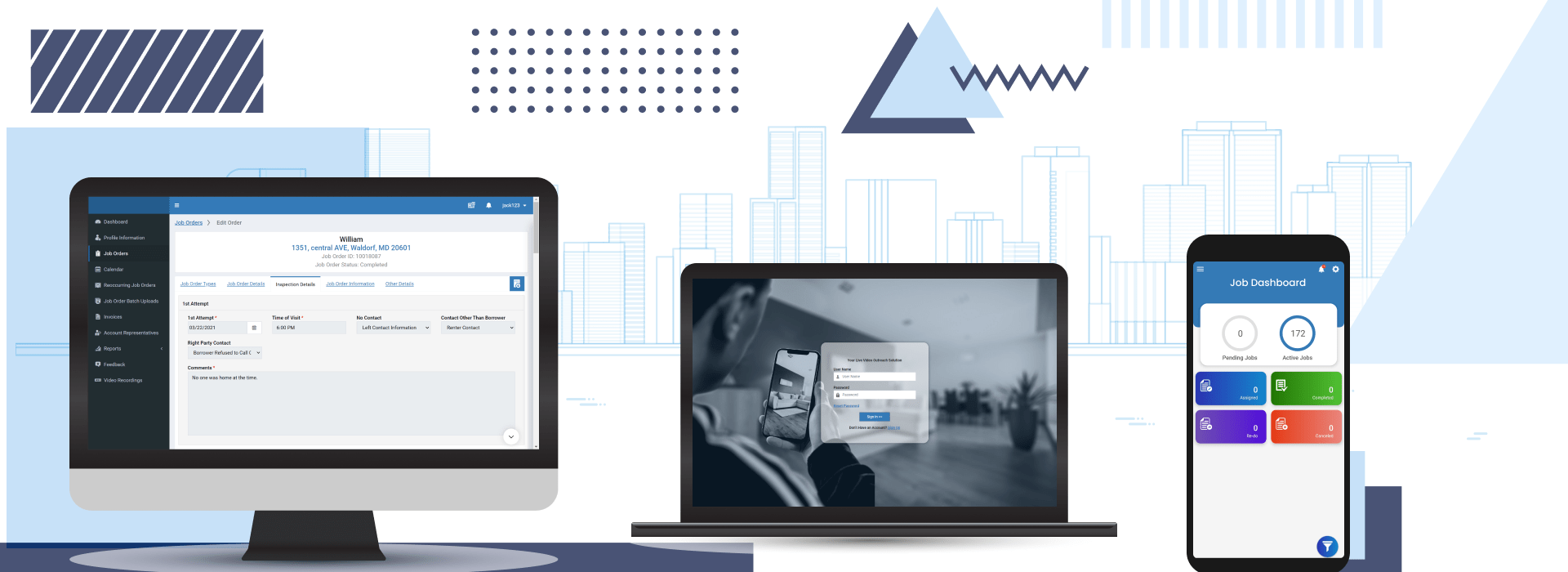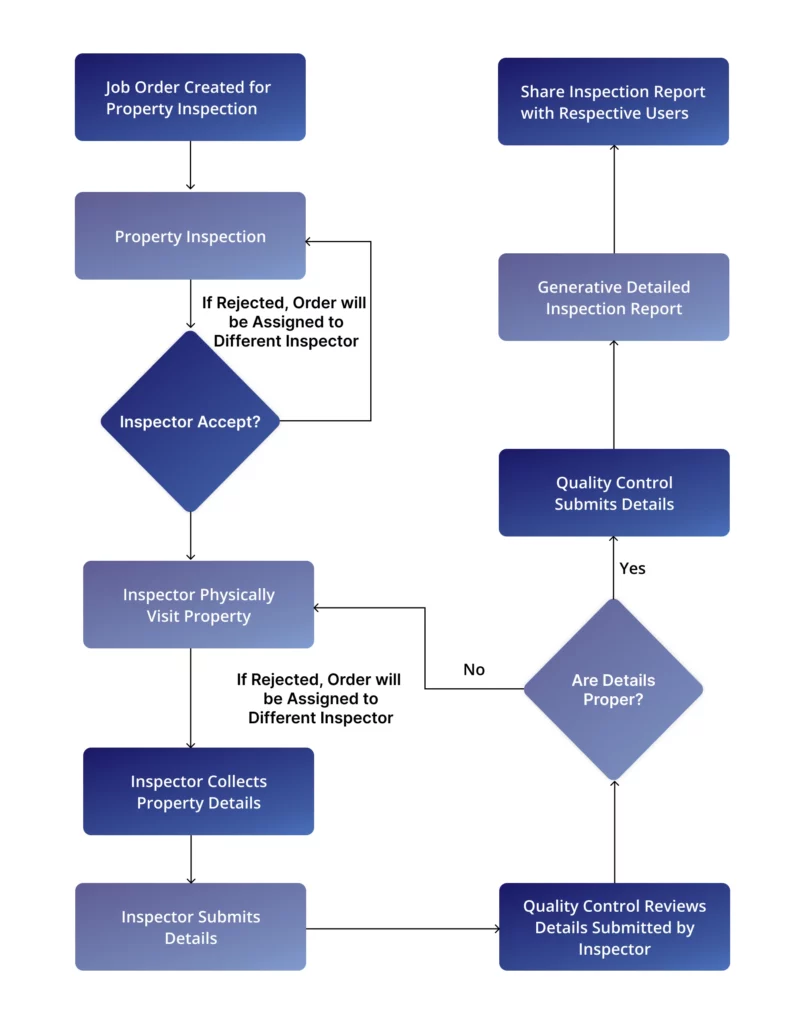Remote Property Inspection Management System

About Client
Industry
Real Estate
Location
USA
Project Overview
Our client faced challenges with the traditional property inspection process, which involved time-consuming steps such as scheduling property visits, on-site manual data collection, manual handovers to staff for review and verification, and finally, the inspection report creation and submission. This approach was not only resource-intensive in terms of time and cost but also susceptible to human errors, fraud, lengthy static forms for all types of inspections, and delays due to manual processes.
In response to these challenges, we introduced a boots-on-ground inspection through a mobile app and remote property inspection through dynamic form generation. To conduct a property inspection, the first job order for the property address is created and assigned the proper dynamic form based on the type of inspection. Then, based on virtual/remote or boots-on-ground requirements, inspectors are assigned to the jobs. Inspectors inspect the property through remote or physical means and fill the required details with pictures. Inspection reports/forms submitted by inspectors are then verified by qualified staff. Upon completion of the inspection, a report for the property is generated and shared with the AMC or property owners.
This dynamic mobile/computerized process minimizes human errors, fraud, lengthy inspection times, and delays in approvals. Qualified inspectors can complete inspections with high quality within 10-20 minutes, and the entire inspection process can be finalized within 1-2 days, significantly reducing the traditional time frame of 1-2 weeks.
Traditional Property Inspection Process
01
Scheduling Property Visits: Coordinating and scheduling appointments for on-site property inspections.
02
On-Site Manual Data Collection: Inspectors manually collecting data and information about the property during the on-site visit.
03
Manual Handovers to Staff: Physical or manual transfer of inspection data and documents to staff for review and verification.
04
Review and Verification: Staff reviewing and verifying the collected inspection data and ensuring its accuracy.
05
Inspection Report Creation: Generating inspection reports based on the verified data, often involving manual compilation and documentation.
06
Submission of Reports: Submitting the final inspection reports to relevant stakeholders, such as property owners or management.
Challenges In Traditional Property Inspection Process
01
Time-Consuming Process: Traditional property inspections often involve multiple steps, including scheduling, on-site visits, and manual data collection, leading to a lengthy process.
02
Scheduling Difficulties: Coordinating and scheduling appointments for on-site inspections can be challenging, leading to delays and inefficiencies.
03
Manual Data Collection: Inspectors manually collect data during on-site visits, which is time-consuming and may result in errors.
04
Risk of Human Errors: Relying on manual processes increases the risk of human errors in data collection, documentation, and reporting.
05
Fraud Risks: Lack of standardized processes and manual handling of documents may expose the inspection process to fraud or misrepresentation.
06
Long Turnaround Times: The entire process, from inspection to report generation, can take an extended period, causing delays in decision-making.
07
Limited Flexibility: Traditional methods may lack flexibility in adapting to changing inspection requirements or unforeseen circumstances.
08
Dependency on Physical Documents: The reliance on physical documents and paperwork can lead to inefficiencies, especially when transferring information between inspectors and staff.
09
Inability to Accommodate Remote Inspections: Traditional methods may struggle to incorporate remote or virtual inspections, limiting their adaptability.
10
Delays in Report Submission: Manual review and verification processes may lead to delays in submitting inspection reports to relevant stakeholders.
11
Delays in Approvals: The manual review and approval process can lead to delays in obtaining approvals or feedback.
12
Static Forms: Reliance on static, paper-based forms may not be adaptable to different types of inspections, leading to inefficiencies.
13
High Costs: The traditional approach can be resource-intensive, resulting in higher costs associated with time and labor.
14
Limited Accessibility: Accessing and sharing inspection reports may be challenging due to physical documents and manual processes.
15
Resource Intensive: Traditional property inspections often require significant human resources for scheduling, conducting inspections, and managing documentation.
Our Solution
01
Dynamic and Customizable Forms Generation: Dynamic forms allow for the creation of inspection checklists tailored to specific property types, ensuring relevant and comprehensive data collection. Forms can be easily modified to accommodate changes in regulations, client requirements, or inspection standards.
02
Streamlined Workflow and Approval: Our tools support dynamic form creation, work order creation for property inspection, assigning inspectors, scheduling appointments, and managing the entire inspection process seamlessly. They facilitate smooth communication between inspectors, staff, and clients. Approval processes are expedited with electronic signatures and automated workflows.
03
Remote/Boots on Ground Inspection Capabilities:
Our mobile apps enables boots on ground property inspections, allowing inspectors to assess properties by physically present where in Virtual inspections enable inspectors to assess properties without physical presence, conducted through live video calls, saving time and resources.
04
Offline Inspection Capabilities:
Mobile apps support offline functionality, allowing inspections to work offline in areas with limited connectivity.
05
Real-Time Data Capture:
Mobile apps enable real-time data capture, providing immediate visibility into inspection findings. Data is instantly synchronized, allowing stakeholders to access up-to-date information at any time.
06
Reduced Errors and Inconsistencies:
Mobile-based inspections reduce manual errors associated with paper-based processes. Standardized digital forms help maintain consistency across inspections.
07
Enhanced Data Accuracy:
Digital tools minimize errors associated with manual data entry, ensuring greater accuracy in inspection reports. Standardized digital forms contribute to consistent and reliable data.
08
Time & Cost Savings:
Mobile inspections allow for faster data collection and reduce the need for physical paperwork which ultimately reduces the time required for on-site visits and costs associated with it.
09
Enhanced Reporting:
Finally, the system incorporates a robust feature for generating detailed inspection reports based on the meticulously collected data. After the completion of the inspection process, this functionality seamlessly processes the gathered information and compiles it into comprehensive reports.
10
Generate Invoices:
Invoices are generated for clients, inspectors, and staff by integrating with QuickBooks after the successful completion of an inspection.
Outcome
45% increase in Profit
85 - 90 % reduction in delays
Human error reduced from
10 % to 1%
Significant environmental benefits, including reduced carbon emissions and sustainability promotion
80 - 90 % efficiency increase
80% improved client feedback
85% improved quality of Inspection (benefiting lenders, Insurance industry, Real estate industry, Construction industry, financial institutes and offering better deals)
98 % Boost in Happiness of All the Parties
Features of Real Estate Online Property Listing Platform
Job Order Management / Inspection Management
Dynamic Form Generation to Support Different Types of Property Inspections
Boots-on-Ground Inspection through Mobile App and Mobile Web (Responsive)
Support for Offline Inspections
Effective Appointment Management for Virtual Inspections
Virtual Inspections via Video Call (Recording, Photo Captures, Photo Captures with Labels & Live GPS Coordinates)
Generate Inspection Reports
Support SaaS Model for Inspection/Job Order Management
Google Maps Integration
Generate and Manage Invoices via QuickBooks Integration for Users Involved in the Inspection Process
Update Respective Users via Pull, Push, Email, and SMS Notifications.
Support Single Job Order Creation & Multiple Job Order Creation through Batch XLS Upload
Support Reporting, such as Profit & Loss, Client Reports, Job Order Completion Reports, etc.
Technology Stack
Front-end
- .Net Core
- HTML
- Bootstrap
- CSS
- JS
- jQuery
- Google Maps API
Backend
- .Net Core(Code First Approach)
- Net EF
- Apache Kafka
- RabbitMQ
- Google Maps
Android
- Kotlin
- MVVM architecture
- Google Maps API
IOS
- Swift
- Viper architecture
- Google Maps API
Database
- MySQL

Server
- Rackspace Cloud

Third party Integration
- AWS S3
- SendGrid
- Twilio
- Quickbook
- Survey Monkey
- Inspector ADE
- UPAMS
- EZ Inspection
- Value Link/li>
Flow Diagram Of Remote Property Inspection Management System


